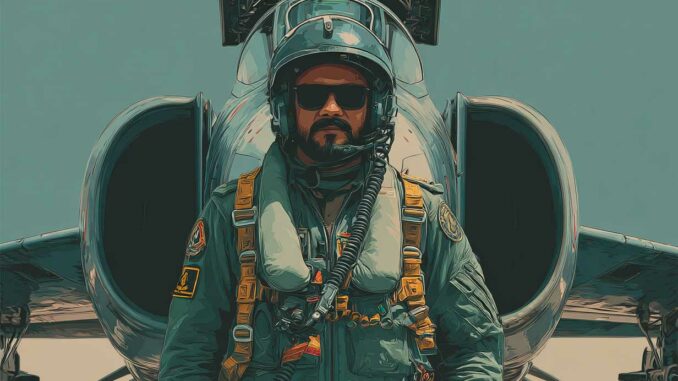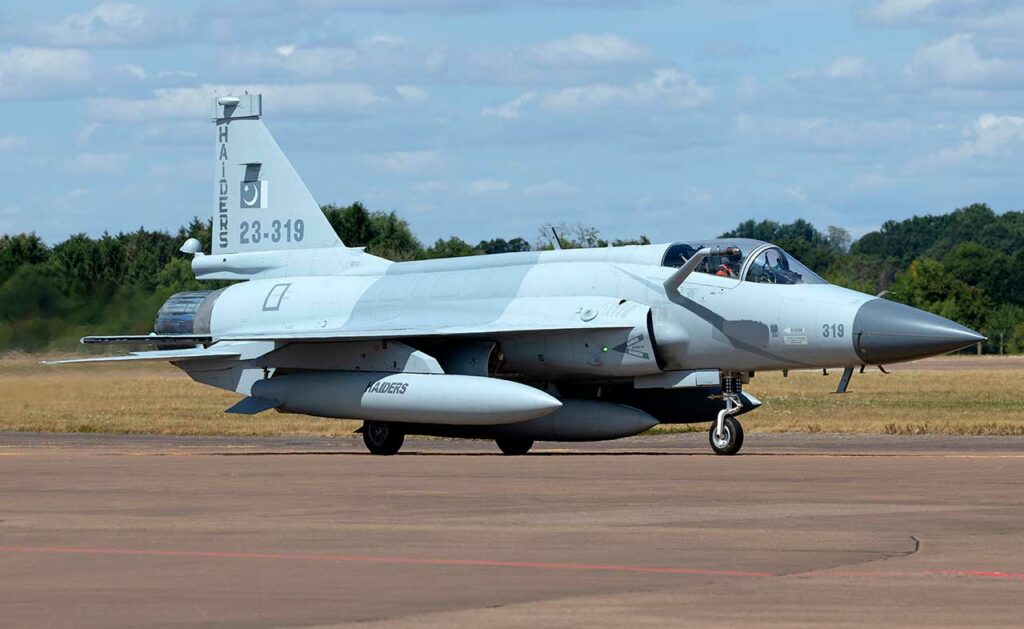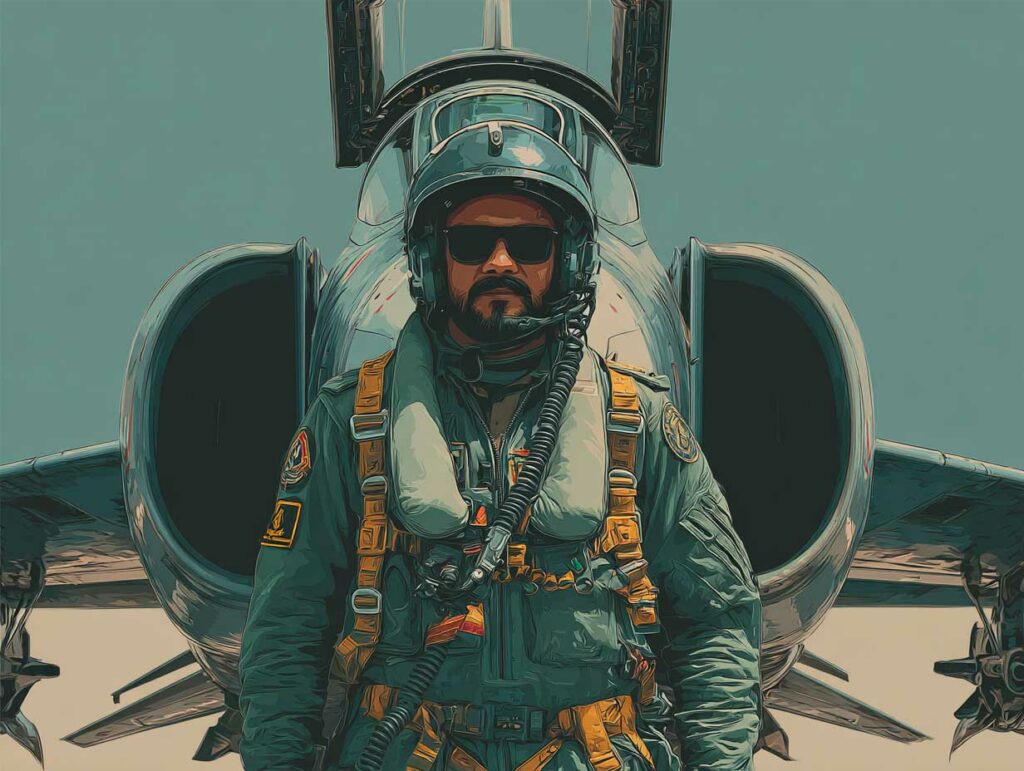
A detailed analysis of the Pakistan Air Force: personnel by type, bases, availability, pilot training, priority challenges, and regional geopolitical impacts.
Summary
The Pakistan Air Force is an agile regional air power, engaged in a gradual modernization program centered on the JF-17 Block III and J-10C, while retaining its legacy fleets of Mirage and *F-7 *. Its active fighter fleet numbers around 300 aircraft, supplemented by *Erieye AEW&C* surveillance assets, Il-78 tankers, and domestic (Shahpar II) and Turkish (TB2) drones . Availability varies greatly: the modern fleet remains generally between 60% and 75% depending on the type, while older aircraft experience lows of around 40-60%. Training is based on a proven pipeline (Super Mushshak, K-8, OCU) with real expertise in exporting training. Five challenges dominate: budgetary and logistical sustainability, withdrawal of older fleets, exposure to sanctions regimes, ground-to-air defense density around bases, and flight hour volume. Faced with Indian Rafales, the PAF is banking on AESA, the integration of the PL-15, and a compact C2/AEW&C network; However, the balance remains fragile and dependent on the flow of parts and training.

The difficulty of obtaining information
Determining the “exact and operational composition” of an air force involves information that is partially sensitive: public figures vary depending on the source, withdrawals and cannibalization are constantly changing, and temporary unavailability is not published. The analysis below aggregates the most reliable open data and cross-references it with recognized battle orders and annual inventory reports. The totals indicate “assets in service” and not instantaneous availability.
The combat fleet: the backbone, reinforcements, and legacy
In 2025, the backbone rests on three pillars: JF-17, F-16, and J-10C, to which are added Mirage III/5 aircraft that are still useful for attack and reconnaissance.
- The JF-17s: approximately 120–130 aircraft in service (Block I/II series, JF-17B two-seaters) and a ramp-up of Block III (AESA KLJ-7A, helmet-mounted display, PL-15 integration, modernization of data links). This fleet is gradually replacing the aging F-7s and Mirages and is becoming the “backbone” of Pakistan’s fighter force.
- F-16s: approximately 75 active aircraft (MLU of various origins and Block 52+ at Shahbaz), dedicated to interception, precision strike, and tactical air defense missions, with a high level of sensor-weapon interoperability. However, availability depends on constant access to parts and ITAR updates.
- J-10Cs: around 20 aircraft already delivered, to modern export standards (AESA, electronic warfare, long-range missiles). This fleet provides credible BVR reach against the Indian Rafale and MiG-29. Additional tranches are being discussed to reach around 30 or more.
- Mirage III/5 (ROSE programs): 100-130 aircraft still listed historically, but a smaller operational fraction, focused on assault, reconnaissance, and certain ASM missions. Their gradual withdrawal depends on the delivery rate of the JF-17 Block III and, to a lesser extent, the J-10C.
- F-7s (MiG-21 derivatives): around 70+ still in service, declining role, mainly advanced training/secondary combat, in the process of being phased out.
Support “above”: AEW&C, refueling, and transport
The PAF has reestablished a balanced AEW&C core: Saab 2000 Erieye and Y-8 (ZDK-03), representing a combined fleet of around 7–8 active platforms, depending on the year. These sensors multiply the effectiveness of JF-17, F-16, and J-10C patrols, especially in BVR. In-flight refueling relies on four Il-78 MP aircraft. Tactical transport relies on C-130 (B/E/H/L-100), CN-235, Saab 2000, and Y-12 aircraft for intra-theater operations, supplemented by government aircraft for specific missions.
Rotary wing aircraft and SAR
The PAF operates a light search and rescue and support fleet: AW139, Mi-171, SA330, SA316, Bell 205/212. The SAR/CSAR core has been professionalized around the AW139, centralized in particular within 88 Squadron, with a mission of rescue, medical evacuation, and advanced NVG training. The maneuver helicopter fleet remains the major responsibility of the Army.
Drones: from domestic to Turkish
The MALE segment is progressing: Shahpar II (GIDS) in ISR/light attack, Burraq legacy, and documented integration of Bayraktar TB2 within the PAF (ISR and guided munitions). Public indications point to an ISR-strike “ecosystem” that is moving upmarket (integration of local and Turkish munitions, targeting doctrine for the benefit of fighters).
Pilot training and instruction
The pipeline is clear and proven:
- Primary on Super Mushshak (MFI-395), produced locally in Kamra;
- Advanced on K-8P Karakorum;
- Operational conversion (OCU) on JF-17B, FT-7 or dedicated squadron airframes;
- Continuing education through the PAF Academy Asghar Khan (Risalpur) and instructor schools.
The PAF exports this expertise: cooperation with Iraq, Iran, Belarus, and Azerbaijan on basic training and tactical ramp-up. The sensitive link remains the annual “volume of hours” per pilot: in a constrained budgetary context, maintaining 140–180 hours/year for front-line fighter pilots on a sustainable basis is a challenge. Simulators partially mitigate this shortfall, but cannot replace actual flight time for consolidating air-to-air and air-to-ground skills.
Distribution by bases and roles
The system is structured around ten major projection and support axes:
- PAF Minhas Base (Kamra): J-10C (No. 15 Cobras), JF-17 Block III (No. 16 OCU), AEW&C Saab 2000 Erieye, SAR (Alouette/Mi-171/ AW139). Key positioning for high intensity and aeronautical production (PAC Kamra).
- PAF Base Shahbaz (Jacobabad): F-16C/D Block 52+ (No. 5 Falcons) and F-16 MLU (No. 11 Arrows), SAR AW139. Leading base for interception and precision strike.
- PAF Mushaf Air Base (Sargodha): historic fighter hub with F-16 MLU, multi-role Combat Center (CCS), and multi-role squadrons.
- PAF Rafiqui Air Base (Shorkot): Mirage III/5 (ROSE II/III), Mirage OCU, assault/reconnaissance missions.
- PAF Base Masroor (Karachi): JF-17 (including Block III), coastal support and southern coverage, proximity to maritime logistics.
- PAF Base Bholari (Jamshoro): F-16 A/B ADF and JF-17, plus AEW&C on detachment.
- PAF Base Peshawar: JF-17, northern interception role and coverage of the Khyber axis.
- PAF Base Samungli (Quetta): JF-17, western coverage and Balochistan.
- PAF Base M.M. Alam (Mianwali): advanced training (K-8P, FT-7/OCU) and SAR.
- PAF Base Nur Khan (Rawalpindi): transport, Il-78 refueling, government liaison, and federal command.
In addition, there are forward bases (Skardu/PAF Qadri, Multan, Faisalabad, Rahimyar Khan, Pasni, Gwadar, etc.) that can be activated in a crisis to reduce response times and disperse fleets.
Operational availability: a “family” approach
There are no official published rates. By cross-referencing average age, logistical complexity, dependence on imports, and feedback from exercises:
- J-10C: recent fleet, tight support chain with China; we can estimate a 65–80% niche in “peace” mode, depending on the batches.
- F-16: historically high-performing, but sensitive to ITAR constraints; 60–75% when parts flows and updates are on track, more for Block 52+.
- JF-17 Block I/II: availability varies depending on sub-series and RD-93 engines; 55–70% realistic, with an ambition to increase via Block III retrofits.
- Mirage III/5: aging, frequent cannibalization; 40–60% on average, with remarkable national technical expertise extending useful life.
- AEW&C: “gold” availability to be preserved; a high rate is generally prioritized (strict scheduled maintenance), as it is the core of informational superiority.
- Refueling/transport: subject to heavy maintenance cycles, but massed on C-130s; adequate availability if cannibalization is limited.
These orders of magnitude are strained in times of crisis, with the PAF then prioritizing the most modern airframes for air-to-air posture.
Armament: the BVR and stand-off gamble
The strategy is clear: to make BVR engagement more reliable via AESA and long-range missiles (PL-15 on the J-10C/JF-17 B3 side) and to maintain a high-performance Western base on F-16s (AMRAAM, designation pods, JDAM/PGM). In air-to-ground, the arsenal combines conventional guided bombs, Chinese anti-ship missiles, and regional stand-off missiles (Ra’ad/“Taimur”) on dedicated platforms (including Mirage). C2 integration (AEW&C, national data links, ground radars) determines overall effectiveness in confined airspace.
The state of training: quality, volume, and cooperation
The PAF has a solid reputation for basic and tactical training, backed by its Super Mushshak and K-8P training aircraft and an “instructor” culture. It offers training courses to foreign forces (Iraq, Belarus, Iran), a sign of a structured doctrinal apparatus. The challenge? Maintaining a sufficient number of hours to “absorb” young pilots on JF-17/J-10C/F-16 aircraft and preserving the pyramid of experience, while the cost of fuel, engine availability, and budgetary constraints limit the margin for maneuver.
The five major issues to be addressed
- The orderly withdrawal of older fleets (Mirage, F-7): avoiding a “capacity cliff” before the JF-17 Block III is sufficiently numerous and fully mature (sensors, EWS, engines).
- Logistical sustainability under constraints: streamline parts for F-16s (ITAR environment) and secure RD-93/WS-13 chains on the JF-17 side, while maintaining AEW&C MCO.
- Training volume: guarantee a minimum number of flight hours and live firing, supplemented by simulators and Red Air, retain senior personnel to avoid erosion of experience.
- Base resilience: harden infrastructure against stand-off strikes and drones, increase shelters and C-RAM/GBAD capabilities, and densify ground-to-air defense around hubs (Masroor, Mushaf, Shahbaz, Minhas).
- Multi-source interoperability: harmonize Chinese and Western sensors/weapons, standardize C2 procedures and electronic warfare, improve the reliability of data links and cybersecurity.

The impact of the geopolitical environment
- With India: the Rafale equipped with Meteor poses a high-intensity BVR threat. Pakistan’s response combines J-10C + JF-17 B3 + AEW&C + PL-15, seeking to get the first shot and force the adversary into narrow corridors. Recent exchanges and claims of losses highlight the danger of a duel between equals on the Punjab-Kashmir axis.
- With China: a structuring strategic partnership: J-10C supply, JF-17 support, radars, missiles, drones. This is the life insurance of modernization and the key to budgetary/technological leeway.
- With the United States: a utilitarian relationship on the F-16 fleet (support, MLU, parts). Any political hardening could create friction over availability.
- In the West (Iran/Afghanistan): persistent ISR needs, occasional strikes, increased use of drones and special means. The dispersal of squadrons and the activation of FOBs such as Skardu improve response times.
- In the Arabian Sea: protection of CPEC and coastal routes; the combination of JF-17/AShM, maritime surveillance, and AEW&C fills a need, but the number of platforms remains limited.
The “real” figures: what can be said without speculating?
Based on annual directories and open databases for 2024-2025, the following order of magnitude is reasonable:
- Fighters: approximately 300 fighters in service (including ~120-130 JF-17s, ~75 F-16s, ~20 J-10Cs, ~70+ F-7s, ~100-130 Mirages still in inventory but with a lower active share).
- AEW&C: 7 to 8 platforms (mix of Saab 2000 Erieye and Y-8/ZDK-03).
- Tankers: 4 Il-78.
- Transport: around 20 active C-130, supplemented by CN-235, Saab 2000, Y-12.
- PAF helicopters: around 30/40 for SAR/CS, with AW139 as the mainstay.
- Drones: Shahpar II in service, TB2 observed and operational within the PAF for ISR/guided munitions.
These numbers describe those “in service” and not the fraction of the day capable of generating sorties. In a crisis situation, the PAF would focus its efforts on F-16 Block 52+, J-10C, and JF-17 B3, backed by Erieye.
The outlook: how to strengthen the operational equation
- Massify the JF-17 Block III and retrofit as many Block I/II aircraft as possible (AESA, EWS, links) to reduce the multi-standard logistical footprint.
- Increase the J-10C fleet if finances allow, to provide a consistent air-to-air “fist” to counter the Rafale squadrons.
- Protect the availability of AEW&C and Il-78 aircraft: this is the source of information and patrol endurance.
- Ramp up drones (armed ISR, anti-drone, electronic warfare), an area where local industry is progressing rapidly.
- Invest in airfield protection (layered GBAD, shelters, dispersal, hardening) to ensure sorties can be flown beyond the first 48–72 hours.
- Protect human capital: flight hours, mission simulators, regional Red Flag exercises, instructor retention, maintenance team retention.
Strategic reading: agile air power, but under pressure
The Pakistan Air Force has succeeded in building a credible “modern core” in less than a decade by diversifying its suppliers and capitalizing on its recognized training expertise. This agility comes at a cost: the coexistence of Western and Chinese standards, long supply chains, and a budget subject to severe constraints. The next critical window will be when JF-17 Block III aircraft represent the majority of active airframes and basic defense has gained resilience. If the PAF crosses this threshold while stabilizing its availability and training hours, it will maintain a robust air deterrent vis-à-vis India, while managing friction in the West. Failing that, the “scissor” effect (wear and tear on older fleets, budgetary pressure, logistical tension) could erode the ability to sustain a tempo of operations beyond a few waves of sorties.
War Wings Daily is an independant magazine.